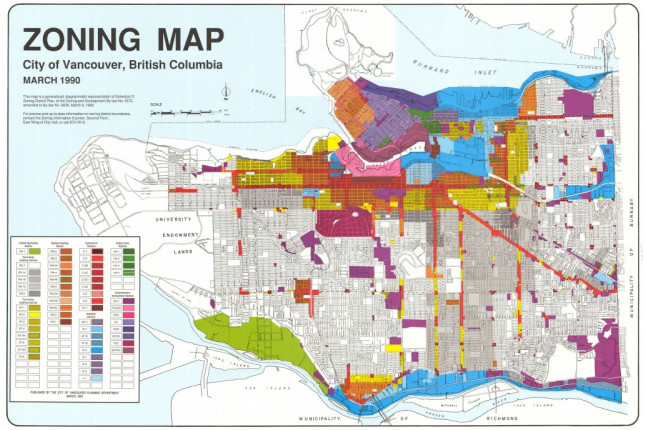
As you begin to plan your custom home, there is a lot of preliminary research to do before drafting up blueprints with an architect or home designer. One of the important things to make note of is your property’s zoning. Your neighbours across the street could be zoned to build something slightly different from what you are allowed, even if you both have the same sized lot.
Let’s take a look at the zoning regulations and basics.
A property’s zoning is typically labelled with an alphabetical letter (or two) followed by a number. For example, you could see: RS-5, R1, CM2, C1.
Any zone beginning in a “C”, regardless of the city (Burnaby, North Vancouver, or Vancouver) is typically indicative of “commercial” zone, “R” indicates “residential” and lastly, “RM” to signify “multi-family residential”. As you can probably guess, any area that is commercial will look way different than residential, have different floor-to-area ratios, building setbacks, etc.
What is important to note is that what may be zoned R4 in Burnaby will not possess the same rules and bylaws as the same zoning of RS4 in the District of North Vancouver (the District varies considerably from that of the City as well) even though they are both “residential #4”. Let’s compare the two as an example.
Lot area and building maximums: In Burnaby, the R4 zoned lot must be a minimum of 6,000 sqft, with a width over 49 feet. While the District of North Vancouver does not specify a minimum lot size, they mention that the maximum principal residential building shall not exceed 35% of the lot size VS in Burnaby the lot coverage shall not exceed 40% with an attached garage.
*Other calculations apply but this is the basis.
Setbacks: Setbacks are the distance that you are allowed to build from the property line or landscape element (ie. Distance from a creek). In Burnaby, the setbacks on that zone are not mentioned but they specify that the front yard depth, which is the distance between the front lot line and the foundation wall or supporting posts nearest the front lot line) must not less than 7.5 meters in depth with side yards each containing a width of at least 1.5 meters. A rear yard in Burnaby must be provided with at least 9 meters of depth. In the DNV, the primary home must be built 7.62 meters from the front and rear and at least 1.22 meters from the side.
As you can see, on those two things alone, that can create a very different home. For example, let’s take a lot size of 8,000 sqft (55 x 145 lot). In Burnaby, you would be allowed to build a 3,200 sqft home plus basement, VS. 2,800 sqft plus basement in North Vancouver. That may not sound like a lot… but it’s basically the size of a typical apartment in New York City!
That’s just one comparison and example. Each zoning contains a lot more specifics that are important to read and learn about while you’re in the beginning stages of your custom home planning, in order to ensure you are on the right path and minimize any delays in the permitting process with each city or district, respectively.
If you enjoyed reading this blog,feel free to share on Twitter or Facebook. More questions about building a custom home? We should talk. Click here to get in touch.